Functional class formation in domestic dogs (Canis familiaris): an approach to the acquisition of pre-symbolic behavior
Main Article Content
Abstract
The present study investigated the possibility of teaching two domestic dogs (Canis familiaris) to respond adequately to two classes of three stimuli (wooden boxes with pieces of food when having S+ function) through a procedure of successive shifts of simple discrimination. Sessions were carried out in a room where two, four, or six wooden boxes were placed side by side. Initially, the subjects responded to two stimuli (a positive [S+] and another negative [S-]) for session. Next, four of the six boxes were presented, two functioning as S+ and other two functioning as S-. In the following phase, successive shifts of simple discrimination were carried out with the four boxes. After that, the training with all six boxes was initiated. Seven tests were carried out. Each test consisted of (1) a discrimination shift with four boxes, with the two remaining boxes kept out; (2) then the two remaining boxes were re-inserted in the experimental room. One of the subjects adequately responded to three of these seven tests and the other to four of them. It is discussed the effect of the emphasis in the visual modality of discrimination and the use of fixed positions of the boxes on the performance of the subjects.
Article Details
How to Cite
de Souza Dahás, L. J., da Silva Brasiliense, I. C., da Silva Barros, R., Dias Costa, T., & Barbosa Alves de Souza, C. (2011). Functional class formation in domestic dogs (Canis familiaris): an approach to the acquisition of pre-symbolic behavior. Acta Comportamentalia, 18(3). Retrieved from https://revistas.unam.mx/index.php/acom/article/view/24309
Citas en Dimensions Service

<a rel="license" href="http://creativecommons.org/licenses/by-nc-sa/4.0/"><img alt="Licencia de Creative Commons" style="border-width:0" src="https://i.creativecommons.org/l/by-nc-sa/4.0/88x31.png" /></a><br />Este obra está bajo una <a rel="license" href="http://creativecommons.org/licenses/by-nc-sa/4.0/">licencia de Creative Commons Reconocimiento-NoComercial-CompartirIgual 4.0 Internacional</a>.
